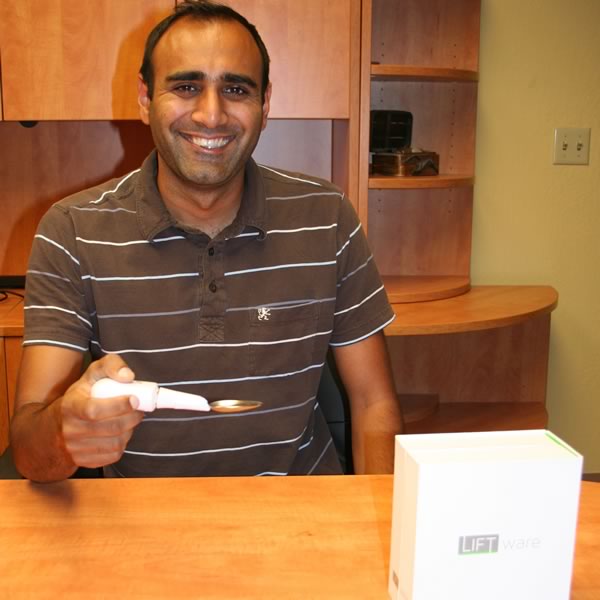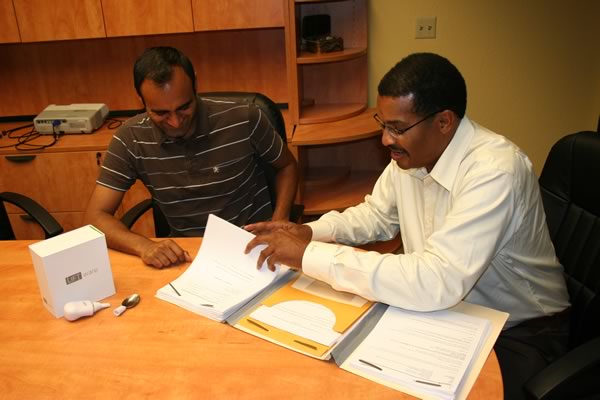
Lift Labs' Anupam Pathak with his Liftware spoon
A Conversation with Anupam Pathak of Lift Labs
Lift Labs, formerly known as Lynx Design, has developed a line of products called "Liftware". Liftware enables people afflicted with debilitating shaking, such as that caused by Parkinson's Disease, to regain control of the utensils most people take for granted. The first such utensil is the Liftware spoon. Lift Labs was founded by the underlying technologies' inventor, Anupam Pathak, who began working with Sawyer Law Group in 2011 to develop the technologies' intellectual property protection. Lift Labs was recently acquired by Google[x]. Anupam stopped by the offices to enjoy a conversation with his associates at Sawyer Law Group, including Managing Attorney Joseph A. Sawyer, Jr.
Tell us about Lift Labs...
Anupam Pathak (AP): Lift Labs is a company I initially started working on soon after graduating from my Ph.D. program. For about a year and a half it was just me. It was kind of the cliché story where I was in my mom’s garage, but I was researching technology funded by the NIH (National Institute of Health) to help stabilize hand tremor. Hand tremor is a big problem, caused by a lot of different neurological disorders. The big one is Essential Tremor and then Parkinsons’s, Multiple Sclerosis, and other kinds of neurodegenerative disorders. Hand tremor will just get in the way of doing daily activity—for a lot of people eating is a huge problem. In that first year, I was meeting a lot of patients and they all said that they wish that they could have a spoon that would help them eat, because a lot of the time they just can't eat certain foods or go out in public.
So the first product from the technology was a device that helps stabilize the spoon, rather than forcing the person’s hand to stop moving, which can be painful (to the person). This device would stabilize what the user is trying to hold. In this case, we have a spoon attachment on the end. That was our first attachment and it worked really well, so that’s what we went to the market with. People are really benefitting from it.
So Liftware came out of research you were doing at school?
AP: It would be more of the expertise in motion stabilization. There (University of Michigan) we were working on a variety of things, including military. I wanted to branch out and find more applications in health and human impact. Once I graduated, I had applied for the brand because I thought it was a great idea and so I headed off to the NIH and they thought the same.
What can you share with us about how Liftware works?
AP: It works in a similar way to image stabilization built in to many cameras. In a camera, there is a little motion sensor that can detect the angle of the camera so if you’re kind of jittering it will actually move the objects inside in the opposite direction and that’s how it keeps the image stable. That works on very small scales. Very tiny activators move the lens so the challenge we solved was: How do we get that concept to move a very large amplitude? If you’re shaking—3 to 5 times a second is how fast people shake—we are able to stabilize about 75% of the motion. That’s enough to make the difference between spilling all over the place and being able to eat successfully.
That is such a worthwhile innovation. Tell us what makes your technology unique and how you went about protecting your Intellectual Property before you came into association with Mr. Sawyer?
AP: What makes this unique is this is the first time anyone’s really done this for people with tremors. The technology—how the actual control is done, where the sensors are placed, and what types of sensors are used—that's unique. The whole system is something unique itself.
As for protecting the IP, both my parents were electrical engineers so I kind of grew up in Silicon Valley knowing about patents. Just from their whole career as innovators and technology people I knew we should protect the IP and I also knew we needed help. A friend of my mother's had a very high recommendation of Joseph's firm, and it's been wonderful.
I think being surrounded by so many good people, also just believing in what we’re doing, believing we’re actually helping people, a lot of people wanted to help and Joseph was definitely one of those people.

Anupam Pathak and Intellectual Property Attorney Joseph A. Sawyer, Jr.
So Mr. Sawyer, when Anupam came through the door three years ago, what did you see in the technology, and in the inventor?
Joseph A. Sawyer, Jr. (JAS): Our firm has had some experience in the general area of motion stabilization, so when he showed me what it did, I quickly understood the technology and the innovation. The other key thing was that this technology would be of great benefit to individuals that had issues with essential tremors. It is my desire that we work with clients who are making a contribution that helps humanity. Not only do we want to be profitable, but we also want to help companies such as Lift Labs that are making a difference in peoples' lives protect their intellectual property. That is an important part of the mission of the firm.
So Mr. Pathak, what role did the Intellectual Property play in your company's acquisition?
AP: It's extremely important to leading, larger companies. It's a key asset. That was something that was very much considered in the whole acquisition, and Joseph helped a ton during that whole process. Whenever there was some new issue that came up, he was always there to help—both on the legal front as well as with personal advice. It’s stressful at times so I think that Joseph definitely understood that and was there to help.
JAS: They needed information about different IP issues from SLG because we were primarily responsible for Lift Labs intellectual property portfolio. We made sure those issues were addressed in the appropriate fashion. Whenever there’s an acquisition, in every similar endeavor, there are IP issues that pop up that people have to deal with. We helped Anupam prepare for these ahead of time, as we were building his IP portfolio.
Our last question today is—what would you recommend that new companies following in your footsteps do with respect to protecting their IP?
AP: As early as possible, people doing a startup need good advisors and people who know what they are doing. We were definitely able to give back to people who helped. For me, it was just so satisfying to be able to do that, because so many people had helped when I couldn’t give back. Finally, when I could it was wonderful to be able to express my gratitude.
JAS: Yes for a while we were being paid in spoons! That was part of the compensation, but I was actually able to give these to some people who needed them. People were using the product and everyone that actually used them have seen great benefit from it.
AP: Yes, paying it forward is the thing.